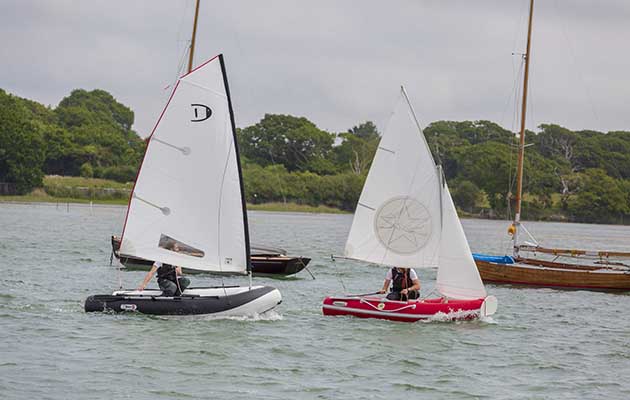Tiwal 2

The metal frame holds the mast and daggerboard and provides rigidity
This was by a good distance the favoured inflatable sailing dinghy of all those on test.
The second iteration of this inflatable sailing dinghy is smaller and faster to assemble than the Tiwal 3 but has retained much of the sailability of the larger model.
Of all those we tested, the Tiwal 2 falls mostly into the toy category rather than being an out-and-out tender.
As such she has no cockpit, with the main inflating hull being something closer to a paddleboard.
A metal tripod holds both daggerboard and mast in position offering a solid frame from which much of the performance of the boat is derived.
This boat also required the highest pressure when inflating.
Though it would be possible to inflate it with the included hand pump – variations of which come as standard with all the inflatables on test – ideally you would want an electric pump to achieve that pressure without either exhausting yourself before you have hit the water or significantly increasing the time it takes to put her together.
With this particular model, setup speed is something of a unique selling point.
The rig is made of a three-piece glassfibre mast that simply slots together like a windsurfing mast.
The Dacron sail features vertical battens making it easy to roll around the mast when not sailing and a two-piece ‘boom’, similar in design to a thick sail batten, slots into a sock at the base of the sail.
Tiwal 2 specifications – Best on test for sailing fun
Price: £4,350
Length: 2.8m
Beam: 1.9m
Total weight: 49kg
Biggest bag dimensions: 148cm x 40cm x 35cm
Assembly time: 13 min
Website: www.tiwal.com/en
Tiwal 2 set-up
The Tiwal 2 was the fastest boat to assemble in our test from packed to ready-to-sail.
In total she took 13 minutes to put together.
Much of this speed came from her simplicity – so even after owning her for a while this time would only come down a fraction.
It must also be noted the final few minutes of building time were largely waiting for the electric pump to finish getting her to the required pressure.

The size of the bags the dinghies are stowed in were measured as part of the test
This will always be a limiting factor in terms of time to the water.
There is little to report on in terms of difficulty or confusion.
She was the easiest boat to assemble.
As with the other inflatables we tested she comes in two bags, one containing the main inflatable hull and the other for rig, sails, daggerboard and rudder etc.
The Tiwal 2 was the second lightest of the boats on test, weighing in at 30kg for the main boat bag and 19kg for the rig bag.
As with everything on test the larger bag is quite cumbersome and would be difficult to carry any distance.
Tiwal 2 test
Sailing
The Tiwal 2 genuinely feels for all the word like a small performance dinghy.
This inspired confidence to throw her around.
She did, however feel possible to capsize, whereas the other sailing dinghies on test felt much more stable.

The sail felt a little small in light winds, but still packed some power
The sail works effectively but was a little short on power in the relatively light conditions on test day.
I suspect with a bigger sail or a bit more breeze a modest-sized crew could easily get her onto the plane.
This would be impressive for an inflatable boat that is small enough to throw into an onboard locker.
Under motor
The boat as tested had no option to attached an outboard making her something of a one-trick pony.
However, the manufacturer has recently developed an engine mount.
This can replace the rudder stocker and is compatible with all models.
Swapping the two over would be a fairly simple process.
Although we found it was much easier to attach the rudder stock when the main hull was partially deflated.
As such, we feel it’s more likely you will decide before use whether you would be using her with a motor or with a sail.
Without a cockpit of any real description, the Tiwal 2 is never going to make a particularly practical tender, although she could carry two adults and a bag or two.
Things on deck are likely to get a bit wet.
Provided you accept this and store your shoreside kit in a dry bag, using her as a tender would be possible.
Rowing
There are no rowlocks so rowing is not an option.
But, without the rig in, you could probably treat her like a standup paddleboard, but she is too large to do this effectively.
YM Verdict
If you want a simple, quick and easy sailing toy that can double as a makeshift tender, this is the one for you.
Realistically, this seems rather more a boat you might store on board and let the kids race around in while you are at anchor.
She certainly sails better than the other options on test and doesn’t pretend to offer much else.




